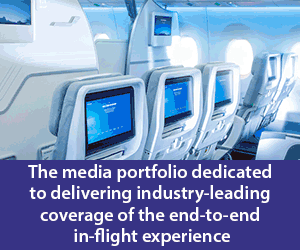Inflight editor Alexander Preston summarises the latest happenings across IFEC and cabin technology.
Viasat is entering its fiscal year 2019 on solid foundations with a ramp-up in its ViaSat-2 (pictured) service and a pretty impressive book of commercial airline orders for its in-flight connectivity service.
Indeed, its IFC business is driving the majority of the increase in quarterly revenues for its Commercial Networks division, largely on the high volume of airborne terminal deliveries, which has brought the company’s second generation terminal installed base to over 200 aircraft across eight airlines and three continents.
Diving down into its IFC growth, the quarter saw the activation of its service on 122 aircraft, the majority of those being retrofits on the American Airlines fleet. According to Mark Dankberg, Viasat chairman and CEO, “We’re actually ahead of that pace so far in the second quarter and we’ve now deployed over 200 planes with our second generation of ViaSat-2 and ViaSat-3 compatible terminals across eight airlines.” Visasat has also been selected by American to outfit its new fleet of 100 A321neos.
In an earnings call with analysts, Dankberg added, “Our current pace will easily surpass 1,000 commercial aircraft in service by the end of fiscal year. The growth in commercial aircraft helped increase our total broadband services revenue on both a year-over-year and quarter-over-quarter basis. As we’ve anticipated in-flight connectivity will become an increasingly significant portion of our broadband services revenue.”
Looking forward he said, “We’re also establishing reputation to have a unique ability to deliver internet, media, content and commerce in the air. We think that’s attractive to passengers and can create competitive advantages for our airline partners and for ourselves. In the long run, we believe that scale in connected passengers will be the catalyst that creates a true multisided marketplace through the internet in the air and that will turn IFC into a win-win-win for all parties.”
He later wrapped up his segment overview, commenting, “We’ve already got the order book in the commercial in-flight connectivity market to drive even stronger growth contributions to our Commercial Networks and Broadband Services segments. We did well in the first quarter and are on pace to do even better in the second. It’s an intensely competitive environment, but we think we’re separating ourselves from the pack in the eyes of the airlines, their passengers and importantly, with the internet, media, and commerce companies that would like to reach those passengers and who can participate in new business models that are win-win-win for all the parties.
“The in-flight connectivity market has been about connecting handfuls of business users with barely adequate internet. We think in the future it’ll be about engaging all the passengers and thinking about connectivity as a means to an end, not just an end in itself. If in-flight connectivity can truly be a multisided marketplace and not just ancillary passenger revenue, then our bandwidth advantage, our low airtime cost and exceptional passenger engagement will be a big differentiator in that environment.”
While surveys highlight the continuing importance of IFC for passengers, Viasat it seems is doing all it can to ensure its airline partners remain at the forefront of the connected passenger experience.
The editor’s comment is published weekly as an accompaniment to the Inflight e-newsletter. If you do not currently receive our email updates, you can subscribe here.






